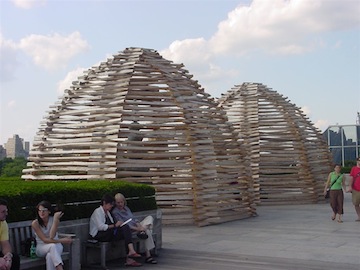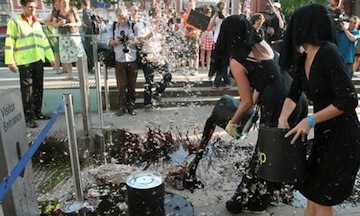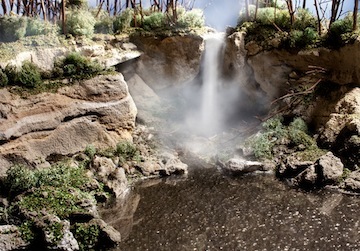Get to the root of the matter. Plant an idea. Sow the seeds.
Call it what you will — the environment, biosphere, landscape, wilderness, terra firma, mother earth, etc. — but nothing is as synonymous with the beginning of life as the flora and fauna that surround and support us. Often we equate the idea of nature with that of a primal past, the origin of all life, a time idealized as pristine and pure in addition to uncompromising, wild, even cruel. Yet simultaneously, discussion of our ecosystems connotes growth, progress, and the future. Using such oft-touted terms as “sustainability” and “renewability,” those individuals concerned with eco-friendliness and “going green” are deemed forward-minded thinkers with their fingertips on the pulse of our modern society’s ongoing evolution.
The natural world has certainly maintained an iconographic and material presence in art since the dawn of human creativity, from cave paintings of vicious predators and hunted prey, to medieval sculptures carved from organic media, to the idyllic landscape paintings of the Hudson River School. The subject did not fully blossom into one inextricably linked with conservation efforts, however, until the 1970s, and for many, the concept of art that comments on or is composed of nature refers specifically to the so-called Environmental Art movement of that era. The problem with this art-historical need to label, categorize, and simplify, is that it offers only a sliver of a much larger thing. Robert Smithson, Joseph Beuys, Walter De Maria, Andy Goldsworthy: these are only a few of many artists whose works have struck up a dialogue about our relationship to, experience with, and reliance on the environment.

Andy Goldsworthy, “Stone Houses,” wood and stone, 2004, Metropolitan Museum of Art, New York City. Image via Flickr. Photo by Thom Watson.
In reality, the intersection between art and nature has never been more dynamic and integral to our daily lives, with the boundaries between the two spheres blurring all around us. Popular media regularly churns out feel-good fluff pieces on artists of the animal kingdom; sandcastle and ice sculpture competitions; or über-illusionistic ephemeral sidewalk art. In television, episode 9 of Bravo’s reality competition Work of Art broadcast the challenge of “mother nature as muse” to couch potatoes nationwide. On the more highbrow side, recent years have seen myriad art exhibitions and installations focusing on themes of sustainability and exploring mankind’s impact on nature through the prism of art: Beyond Green: Toward a Sustainable Art (Smart Museum of Art, University of Chicago; 2005-2006), Plastic Century (commissioned by the California Academy of Sciences for World Oceans Day; 2010), and Rising Currents: Projects for New York’s Waterfront (currently on view at the Museum of Modern Art) being only a few examples.
Works by contemporary artists such as Gregory Colbert and Matthew Albanese appeal to everyone from art aficionados and dilettantes alike, captivating audiences with their flawlessly harmonious, almost quixotic, landscapes. Look no further than Art21’s own roster of featured artists — from Robert Adams to Andrea Zittel — for additional iterations of art-nature dialogues, or to the Art21 blog for occasional posts that touch on our collective fascination with the environment (see Nicole Caruth’s excellent Gastro-Vision post concerning Fritz Haeg’s Edible Estates).
Art news items similarly reveal our eco-mania. A law banning depictions of animal cruelty in video art stirred serious controversy earlier this year, with proponents of free speech emerging victorious over the overbroad restrictions. The oil spill in the Gulf — perhaps THE story of 2010 — elicited some creative activism (sometimes bordering on performance art) in protest against BP’s sponsorship of art organizations. Even Christo and his wrapped landscapes are back on the scene, ruffling feathers with a potentially harmful installation in Colorado, as revealed through a landmark environmental impact statement courtesy of the Bureau of Land Management.

Anti-BP sponsorship protest outside Tate Britain, London, July 2010. Image via the Guardian website. Photo by Dominic Lipinski/AP.
In the next few weeks I’ll be exploring the interplay between art and nature from several different perspectives, touching upon their overlap in scientific fields, the growth of open-air installations, the popularity of sustainable design strategies, and the use of green spaces within our cultural institutions. My goal is to elaborate upon developments you may have heard about, and perhaps introduce you to some things that are new, in order to underscore the prevalence of the natural world in our social conscience, and highlight the ways in which we are attracted to nature as a tool for situating ourselves in the world around us.




